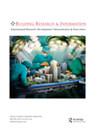Physical environmental factors that affect users’ willingness to visit neighbourhood centres in China
IF 3.7
3区 工程技术
Q1 CONSTRUCTION & BUILDING TECHNOLOGY
引用次数: 0
Abstract
ABSTRACT The physical environment is crucial for creating an attractive and sustainable neighbourhood centre. Previous research has explored various aspects of the physical environments of community public spaces; however, few studies have focused on neighbourhood centres in China or elucidated how to prioritize those factors to affect willingness to visit. A questionnaire survey was used to capture which potential physical environmental factors most affect residents’ perceived willingness to visit a neighbourhood centre. Three hundred fifty-six valid survey answers were collected online from residents of Zhejiang Province, China. The results highlight key physical environmental factors and their relative priorities; safety factors are the most valued by residents, whereas green spaces, number and quietness (which have been discussed in previous studies) are considered generally unimportant. The key factors were classified into three groups: spatial quality, accessibility and spatial capacity. The results presented herein provide new insights from residents about neighbourhood centres. The research developed a comprehensive framework for assessing the physical environment of a neighbourhood centre based on key factor prioritization and grouping characteristics that can guide designers and decision makers in assessing and enhancing neighbourhood centres in communities with limited resources.影响中国用户访问社区中心意愿的物理环境因素
摘要物理环境对于创建一个有吸引力和可持续发展的邻里中心至关重要。先前的研究探索了社区公共空间物理环境的各个方面;然而,很少有研究关注中国的邻里中心,也没有阐明如何优先考虑这些因素来影响访问意愿。使用问卷调查来捕捉哪些潜在的物理环境因素最能影响居民参观邻里中心的意愿。从中国浙江省的居民那里在线收集了356份有效的调查答案。结果突出了关键的物理环境因素及其相对优先事项;安全因素最受居民重视,而绿地、数量和安静度(在以前的研究中已经讨论过)通常被认为不重要。将关键因素分为三组:空间质量、可达性和空间容量。本文的研究结果为居民提供了关于邻里中心的新见解。该研究根据关键因素的优先顺序和分组特征,制定了一个评估邻里中心物理环境的综合框架,可以指导设计师和决策者评估和加强资源有限社区的邻里中心。
本文章由计算机程序翻译,如有差异,请以英文原文为准。
求助全文
约1分钟内获得全文
求助全文
来源期刊

Building Research and Information
工程技术-结构与建筑技术
CiteScore
8.60
自引率
7.70%
发文量
43
审稿时长
>12 weeks
期刊介绍:
BUILDING RESEARCH & INFORMATION (BRI) is a leading international refereed journal focussed on buildings and their supporting systems. Unique to BRI is a focus on a holistic, transdisciplinary approach to buildings and the complexity of issues involving the built environment with other systems over the course of their life: planning, briefing, design, construction, occupation and use, property exchange and evaluation, maintenance, alteration and end of life. Published articles provide conceptual and evidence-based approaches which reflect the complexity and linkages between cultural, environmental, economic, social, organisational, quality of life, health, well-being, design and engineering of the built environment.
 求助内容:
求助内容: 应助结果提醒方式:
应助结果提醒方式:


